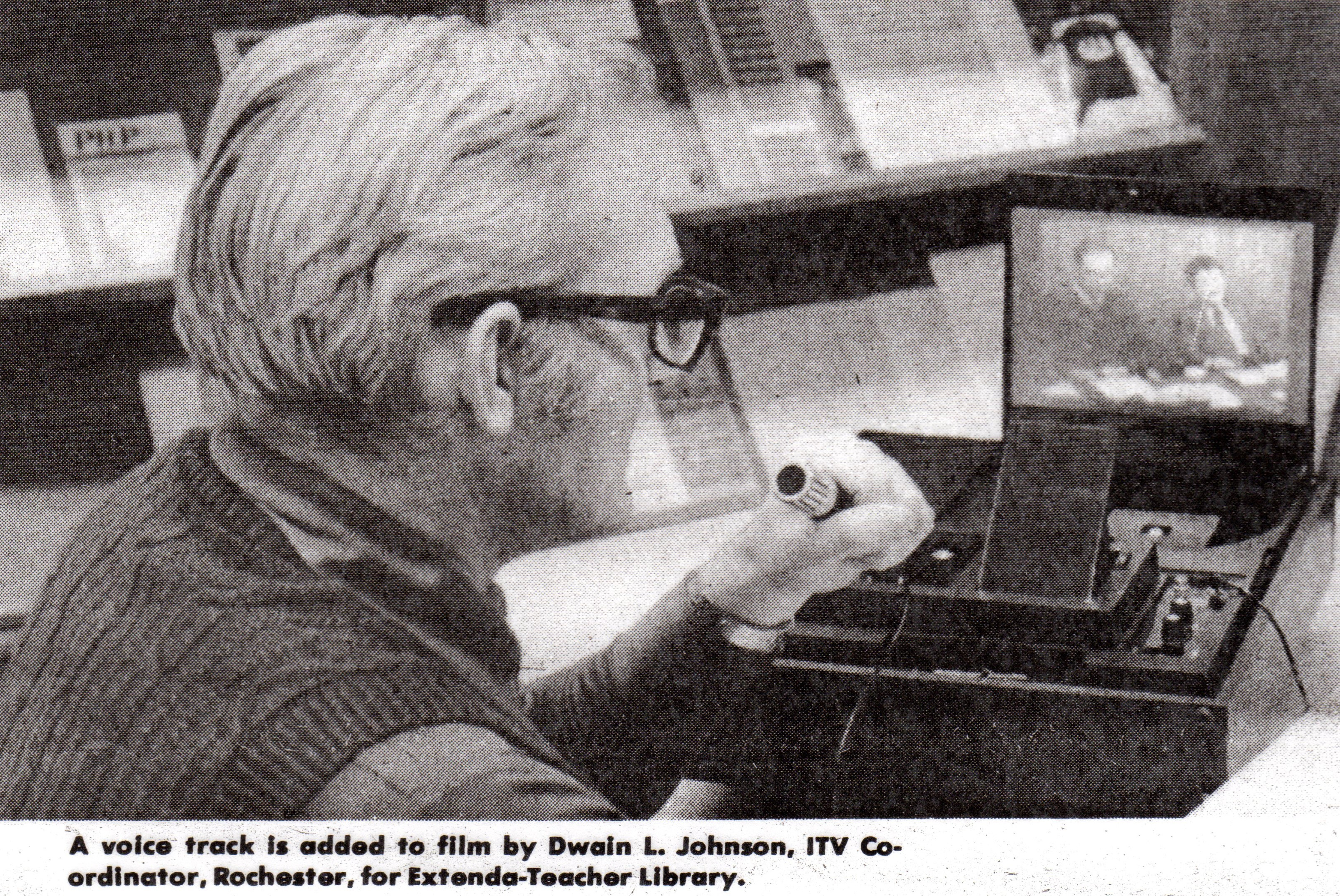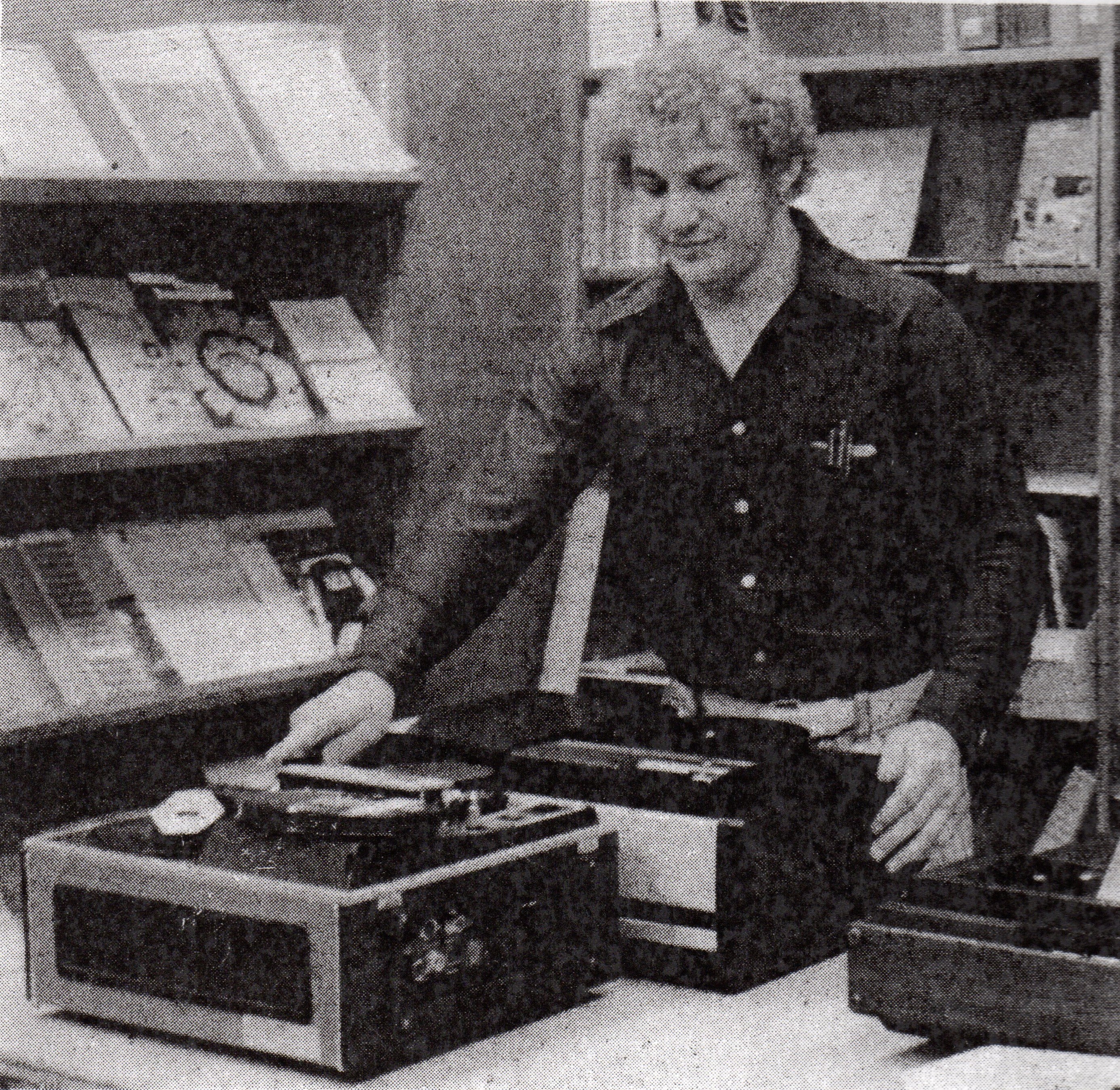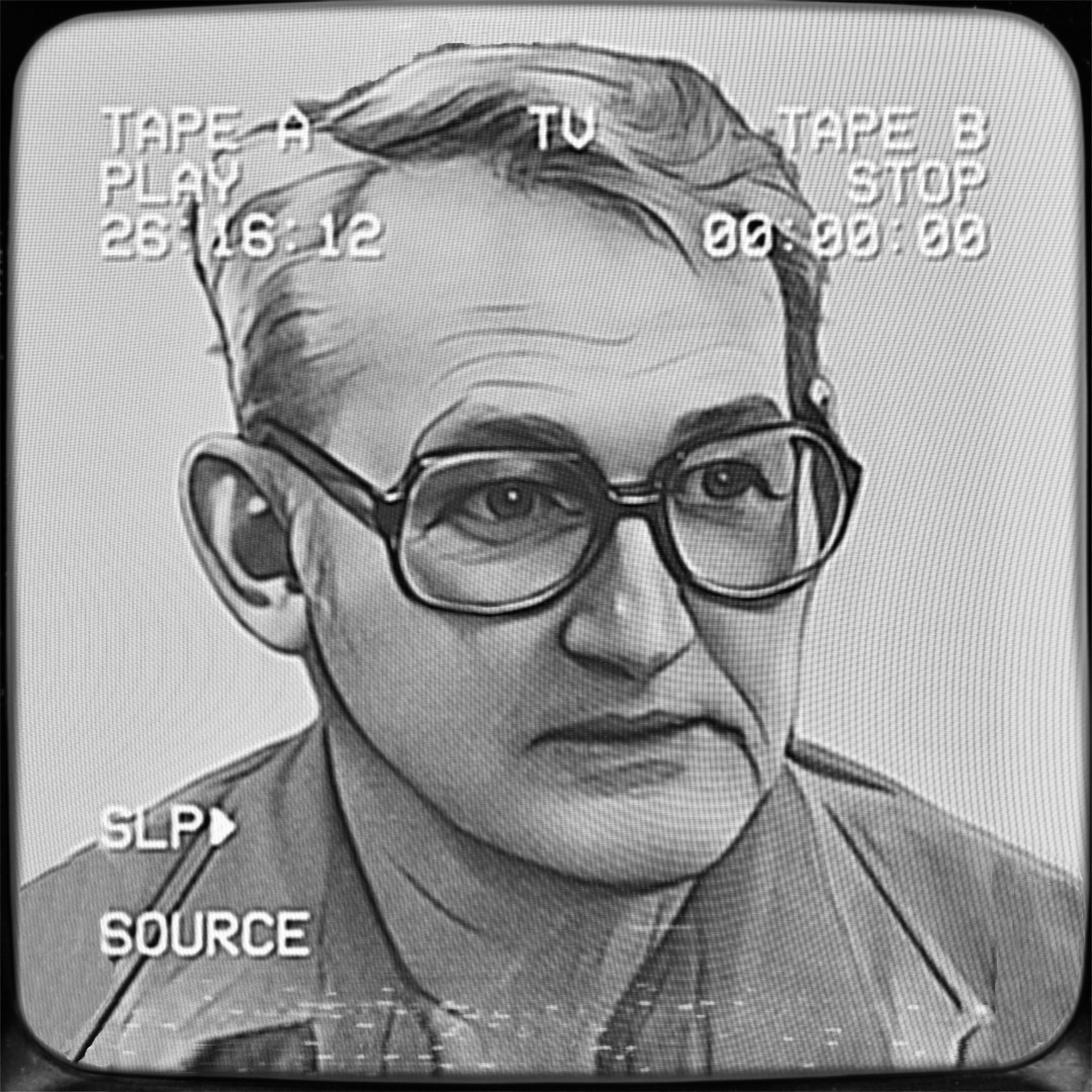Pioneering Instructional Television
"WHY WOULD ANYONE NEED MORE THAN FOUR CHANNELS?"
Navigate to specific stories by using the menu icon in the upper, right-hand corner of this page.
In the late 1960s, Dwain Johnson saw the future and the future was video. Video came in the form of cable TV and video cassettes back then and Dwain saw a huge opportunity for educators to connect and to streamline their classroom media.
Like the Internet 30 years later, there was skepticism and pushback. Teachers worried young people were already spending too much time in front of the "boob tube" or "idiot box." As shared in the main page of this site, administrators couldn't conceive of a future that contained more than four channels.
 |
| Jerry Herman assisted Johnson in running the studio for many years. When Johnson moved to the Rochester Instructional Television Studio, Herman took over as Television Production teacher. |
Dwain, however, was undeterred. He and a student wired the entirety of Mayo High School to a central "TV Studio." The studio was divided into separate rooms. The "live studio" featured three small sets--- one for news, one for weather and sports and one for feature interviews. A control room was next door for the director and board operators. Here, we believe, the very first high school daily newscast was aired.
Next door was a long room that featured rows of JVC Reel-to-Reel video players. During the years I was there, these monsters were replaced by first Betamax (!) and then VHS players. It was here that any teacher in the building could request a certain video to be played at a certain day and time. Students staffed that room and were responsible for starting the tape and fighting the never-ending battle with dirty heads! The videos were obtained by students also being tapped to head to the studio-- sometimes late at night-- to record the programs off the air. During my time as a staff member I saw To Kill A Mockingbird and Flowers For Algernon for the first time.
Copyright laws eventually put a stop to the schools building their own video libraries. Cheap VCRs (and then DVDs) also made it more efficient for teachers to have their own TVs and collections in their room. Now, of course, classrooms have streaming subscriptions. But pioneers like Johnson saw it first and made it happen.
The following is a collection of print media's coverage of the evolution of Rochester Public School's television production.

Mr. J predicts e-learning

Six outstanding media programs will be featured as presentations at the convention of the Association for Educational Communications and Technology in Anaheim, California, March 28-Apr. 2, 1976. The purpose of these presentations is to share models of programs and ideas that conference participants can apply in their home area.
The six Minnesota programs are:
• "Extenda-Teacher" program developed by Dwain L. Johnson, ITV Coordinator, Independent School District 535, Rochester, Mn. Dwain's program was developed from teacher-made 'single concept' presentations which are distributed on closed circuit TV (CCTV). Johnson then went to a film video player that converts the teacher and student made Super 8 color film to an RF signal which is viewed on television. A library of lessons is now available to students who wish to make up missed lessons, review, or go ahead of the class schedule.
• A secondary television journalism course taught by Al Carlson, media specialist, and Ben Kanninen, intern administrative assistant. The two instructors use journalism as the vehicle to prepare their television programs. Class members. share in all phases of writing and producing the programs. Examples of the Duluth program will be presented at Anaheim.
 The following programs were chosen for mini-sessions and will feature:
The following programs were chosen for mini-sessions and will feature:
• Still photography -- Bill Shragg, media director, Osseo Public Schools, will share the photography program as offered in Osseo. Shragg will discuss the various phases of this program and show its implementation in the curriculum.
• A paper duplicating process will be demonstrated by Laurel Benson, AV director, Rochester Area Schools. Benson will be sharing the management and operation of a high speed printing service available to teachers and administrators on a district wide basis. Class quantity service to teachers isoavailable on a 24-hour turn around time. Large runs requiring collating, punching and binding add to the turn around time.
 • Graphic Illustration will be presented by Dennis Johnson, associate director for production in media resources, University of Minnesota. Johnson will be sharing some of the production techniques of projected graphics for television and classroom use.
• Graphic Illustration will be presented by Dennis Johnson, associate director for production in media resources, University of Minnesota. Johnson will be sharing some of the production techniques of projected graphics for television and classroom use.
Dioramas and the use of Vacu-forms to make education come to life will be presented by Robert H. Bruns, AV director, Fergus Falls Public Schools. With the use of models Bruns is ready to help students relive the Civil War or take a 'field trip' to the moon.
THE POST-BULLETIN, Rochester, Minnesota, March, 1976Mr. J predicts e-learning

The Extenda-teacher concept came, not in one inspired moment, but as the result of a variety of television adventures.
Our television equipment was first used for such peripheral processes as self-evaluation, self-observation, off the air viewing, as a medium of student expression, and preserving guest's presentations. This was enough usage to keep our equipment in use as a teacher aid, but I still thought of ITV as an extension of the teacher rather than an aid to the teacher.
The first move we made in that direction was to place the oral presentation material on a series of 78 single concept tapes for a geometry course. Television sets were available to the geometry students and a telephone was installed that gave the geometry students direct access to the TV studio. Lessons were transmitted on demand at any time the students wanted them.
"I still thought of ITV as an extension of the teacher rather than an aid to the teacher" |
This project worked well, with the teachers being more available for one-to-one assistance to students, students working at their own pace, review being immediately available, etc. but the group interaction did suffer so, although this method appeared to be superior to the lecture method, it was still not the answer we were looking for. Hence the development of "Extenda-teacher."
THE PROGRAM: As the curriculum is determined and organized, an effort is made to break down each unit of instruction into those specific concepts which constitute the comprehension of that unit.
The teacher then presents each unit in a way he or she feels is most effective. An evaluation instrument is then administered that is keyed to indicate which concepts are understood and which are not.
The class does not spend time on review, but rather each student assumes the obligation to view an instructional tape which presents again the concept which he did not. understand. This, in turn, is followed by another evaluation instrument until the concept is understood.
On the other side of the achievement spectrum, enrichment tapes are available which will present concepts beyond the minimum requirements of the course. Whether or not comprehension here is evaluated can be at the discretion of the teacher.
THE IMPLEMENTATION: The scripting of the single concept tapes should be done by the classroom teacher with the technical assistance of someone with film or tape production experience.
The shooting of the concept is most effectively done with Super 8 film in either black and white or color. The sound can be put on at the time of the shooting or added later.
After the film is edited and sound dubbed, it can be mounted in a cartridge for viewing on a screen, or transferred to video tapes with a Kodak VP-1 or a similar machine. The video tapes can then be delivered (electronically or manually) to their use-locations.
Whether from a central. transmission location: or with individual machines, the taped single concepts must be available to students on demand.
Changes can be made in the master film at any time by cutting out an undesirable segment or inserting an additional segment without interfering with the quality of the rest of the film.
ADVANTAGES: The teacher can teach his class in the manner in which he is most effective and most comfortable.
"Spilloff" from the educational process will not be ignored, but will satisfy instructional needs without additional time demands on the teacher.
A teacher can be held accountable to the minimum requirements of a class without teaching only toward them.
Makeup work can be handled outside of class time.
Group interaction is maintained but individualized instruction is used when it is needed.
The cost is within school budgets.
THE POST-BULLETIN, Rochester, Minnesota, March, 1976
Seniors Peter Erdman and Dawn Bradley operate the console during a live broadcast of the Sparten Scene [Post-Bulletin Photo by Jim Welch]
The floor manager strides through the room while the weather girl giggles over her script, the anchor-woman shoves her feature story to the producer for checking and the cameramen position themselves, awaiting the signal.
The Spartan Scene, wrapped in a tangle of electric cord, is about to begin.
With a harsh shout of "Quiet out there the chaos fades and smiles spread on the faces of the two announcers, who have just aged five years in a show biz aura.
Throughout Mayo High School, some 2,000 students and staff mem-bers listen intently to the live new-cast.
"If you're the worrying kind, you'd think it would never come out, right," laughs Dwain Johnson. He is the man largely responsible for this innovative program, and for student newscasts at John Marshall High School, John Adams Junior High School, and Winston Churchill Elementary School.
The experimental Spartan Scene, which began four years ago, has become the model for taped newscasts at the other schools. Rochester is a leader in producing instructional films and student-directed news programs. Johnson says he knows of no other district as advanced in original programming. Mayo is designated the district studio.
Newscasts, as well as films made by students of plays, skits, and musical offerings and advertisements, constitute one of the latest uses of television in education.
Production equipment is available at many Rochester schools, but not all make use of it because problems arise in finding staff time and space for a studio, Johnson says.
Instructional television has burgeoned in Rochester over the past 20 years. The program's budget this year is V.21,500, which includes only funds for purchase of equipment and minor charges, not personnel costs.
In its first year, 1968, the budget was only $3,000. Soon afterward it was raised to about $8,000.
Next year's budget will be about the same as this year's, according to Max Walton, associate superintendent for instruction.
All but four Rochester schools now have closed-circuit television. Elton Hills, Hawthorne and Gage Elemen-tary schools will be wired in the near future, Walton said. limber Valley Elementary School is beyond the range of Teleprompter Cable TV, which is required in its franchise to provide the schools' cable hook-ups.
With closed-circuit TVs, the schools can put instructional materi-als on the cable which students see on sets in the classrooms. Expanded use of cable is being discussed by school administrators and teachers.
At the new junior high school in southeast Rochester, a studio for TV and radio production will be built into the library.
In-school production is the thing of the future, Johnson says enthusiastically. At Mayo, the format of the "Spartan Scene," aired daily, is creative. A typical newscast includes announcements and reminders, a list of the birthday students of the day, possibly a television show review, editorials, advertisements, a weather forecast, and maybe even a feature poking fun at the teachers.
The content at times is light-hearted, but never taken lightly, according to Johnson and studio man-ager Jerry Herman.
Johnson says Mayo does the show live because it develops discipline. "We don't let the kids think it's okay to make a mistake." But he also adds that the TV crew is a "proud group" motivated to do well.
The extracurricular activity also enhances the students' communication skills, Johnson says. They write their scripts, read them before a large audience, and criticize them-selves afterwards. Other students learn the fundamentals of television technology by operating the cameras, console, and other equipment.
At John Marshall, the "Rocket Report," a weekly taped program, was started this fall, though equip ment had been available for five years.
"Parents would often ask me why JM didn't have anything like Mayo does," says Johnson. "It just hadn't gotten off the ground there. It takes the right person in the right place."
The "right" qualities were found in Chuck Harkins, an English teacher, and Art Pavlish, the audio-visual technician. The two have worked together to build a studio from a classroom.
Beginning in January, Harkins will teach a TV production course and concentrate on getting a live "Rocket Report" on the cable daily by the end of the school year.
One of the goals for JM's TV production is to tape athletic events from Rochester Stadium for public viewing on the community cable television Channel 13.
At John Adams, space was squeezed out of the library this year to make room for a studio. This fall, students began working on the Rebel Report under the direction of Mary Slicho, a speech teacher.
"We're doing as much as we can on a limited basis," says Sheba.
Winston Churchill is the only elementary school involved in television production. Several years ago, the ITV department offered to set up a studio at the school that developed the best plan for using the equipment. Churchill was selected, and the studio has since been strongly supported by the parent-teacher-student associa-tion.
Wilfred O'Reilly, a sixth-grade teacher, is studio director this year. Last year the program was run by parent volunteers, who still help out. The studio produces three programs a week, ranging from announcements by the principal to interviews with the teachers.
The TV programs, Johnson says, help bring students and staff together. For example, at Mayo and John Adams, new students are interviewed about their interests and back-grounds.
At Mayo, the Spartan Scene gives the TV crew a chance to "tell the Mayo story," in Johnson's words, and develop a positive attitude toward the school.
Mary Stanislav, THE POST-BULLETIN, Rochester, Minnesota| How to be a More Effective Television Performer The final professional chapter of Mr. J's life was as the District Coordinator of the Rochester Public School's Television Studio. He passionately advocated that educators take control of social messaging themselves. To that end, he believed that training teachers to appear on-camera was essential. This is a brief segment of his video How to be a More Effective Television Performer. |
Mayo High's TV Programming Branches Out on Own Channel
December 4, 1978
The Mayo High School television studio will get its own channel by January, enabling it to transmit instructional materials through Tele-prompter Cable TV to 22 other schools.
As part of the cable company's refranchising process last spring, Tele-prompter was required to install the equipment necessary to allow the Mayo studio to send videotapes to the schools on its own "rnidband.- or non-standard channel.
On a mid-band channel, home television viewers are not able to pick up the signal because it is between the regular bands on which the cable company transmits programs.
The school district will have to buy converters for each of the schools, at a cost of about $40 each, so the television sets can receive the signal. The district will also have to pay for maintenance, power charges and a "reasonable" interest charge, ac-cording to the new franchise. These costs have not yet been tallied, ac-cording to instructional television coordinator Dwain Johnson.
The purchase of the converters and other expenses will have to be ap-proved by the School Board, but Johnson said he expects that installation will begin in January or soon after.
The major benefit of the new equipment will he to make distribution of video tapes much more efficient. Instead of having to transport the films to each school upon demand, the studio will broadcast them and the schools can either view them or record them for future use.
A task force of district teachers. audio visual staff and administrators recently met to discuss expanding instructional television.
Their suggestions included more in-service training for teachers, tapes of courses for large groups of students, taped field trips which would bring the experience to the students without their leaving the school, and taped teacher lectures to free teachers for more individualized instruction. Some of these ideas have been tried on a limited basis, Johnson said. He is urging the administration to allow two or three teachers next summer to put their courses on tape. Johnson says such taped lessons would allow students to work at their own pace under the teacher's direction. Those ahead of the group could view enrichment tapes and those behind could get remedial help. Doing this would alleviate boredom for some students and confusion for others Johnson said.
Mary Stanislav, THE POST-BULLETIN, Rochester, Minnesota

